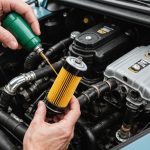Importance of Leather Care for British Convertibles
Maintaining leather upholstery in British convertibles is essential for preserving both its aesthetic appeal and structural integrity. Leather in these vehicles boasts unique qualities such as a bespoke finish and traditional craftsmanship that necessitate particular attention in upholstery maintenance. Failure to care for these luxurious materials can lead to premature aging, affecting both the look and durability of the leather, diminishing the vehicle’s overall value.
Neglecting regular leather care accelerates wear and tear, manifesting as cracks, discolouration, and stiffness. These issues not only detract from the vehicle’s elegance but can also compromise comfort and functionality. Therefore, committing to consistent maintenance is vital for prolonging the life and beauty of the leather.
Regular leather care offers numerous benefits. Consistent conditioning can enhance the leather’s natural resilience against environmental factors like UV rays and humidity, which are common challenges for convertibles. Such proactive care reduces the risk of damage while increasing longevity. Furthermore, well-maintained leather contributes positively to resale value, reinforcing the importance of proper upholstery maintenance. Thus, investing time in routine care is a practical decision for devoted owners of British convertibles.
Practical Care Tips for Leather Upholstery
Embarking on a proper leather upholstery care routine is crucial for the longevity and beauty of British convertibles. The following tips can guide you in maintaining this delicate material.
Regular Cleaning Routine
Establish a consistent cleaning schedule to keep leather free from dirt and debris. Frequent light dusting using a soft, dry cloth can prevent abrasion that may occur due to accumulated particles. More thorough cleaning should take place every 2-3 months, ensuring that natural oils remain intact, preserving the leather’s inherent suppleness.
Conditions for Cleaning
When cleaning leather, it’s important to work in conditions that protect the material. Avoid direct sunlight and use an ambient temperature space. If leather is wet or too dry, the material is more susceptible to damage. Ensuring the right environment aids in maintaining its quality and appearance.
Recommended Cleaning Products
For effective maintenance tips, employ gentle cleaning solutions specifically designed for leather. Products like pH-balanced leather cleaners not only safely remove grime but also preserve the leather’s natural sheen. It’s best to steer clear of harsh soaps or heavy-duty cleaners that may strip oils and cause dryness. Familiarise yourself with recommended products to safeguard your upholstery effectively.
Common Leather Maintenance Issues
Caring for the leather in British convertibles involves more than routine cleaning; understanding and anticipating convertible issues is crucial. Firstly, exposure to UV rays is a major concern. Direct sunlight can lead to fading and drying, resulting in cracks. Preventative care, such as using protective covers or special UV-protectant sprays, helps mitigate this damage.
Moreover, as convertibles are exposed to the elements, moisture and humidity pose significant threats. These conditions can lead to mould or mildew, damaging the leather’s structure. It’s essential to ensure proper ventilation and dryness after exposure to rain or damp environments.
Regular inspections for signs of wear and tear are also part of effective upholstery maintenance. These signs include changes in texture, discolouration, or emerging cracks. Identifying these issues early allows for timely interventions, avoiding costly repairs.
By being aware of these common leather problems, owners can enact suitable measures to protect their vehicle’s interior. Remember, regular preventative care is both a shield and a solution, preserving the leather’s quality and extending its lifespan.
Recommended Products to Use or Avoid
Selecting the right leather care products for British convertibles is crucial to maintaining their elegance. Leather conditioners and protectants are essential, but not all are equal. Top-rated choices often include conditioners that enhance flexibility and protect against UV damage, such as Leather Honey or Lexol. These products are formulated to penetrate deeply, preserving the suppleness of the leather.
Avoid using common household products like detergents or alcohol-based solutions, which can strip the natural oils and cause dryness or cracking. These harsh substances may do more harm than good, affecting the leather’s longevity and appearance.
When choosing products, consider the unique attributes of British leather upholstery. Opt for items that are specifically noted for their gentle formulation and moisture retention properties. Products designed for British leather often account for its distinct quality and ensure thorough care without compromising its texture or finish.
When you’re selecting leather care products, always research thoroughly. Read product reviews, understand ingredient lists, and when in doubt, consult with experts specialising in convertible maintenance. Proper product selection is a small investment with significant returns in preserving your vehicle’s luxurious interior.
Common Leather Maintenance Issues
Addressing convertible issues involves understanding the primary threats to leather. Exposure to UV rays significantly affects leather, causing fading and drying, which can lead to cracks. The solution lies in proactive preventative care. Utilising UV-protectant sprays and covers helps safeguard against direct sunlight, preserving the leather’s colour and elasticity.
Moisture and humidity present additional challenges for British convertibles. Prolonged exposure can lead to leather problems like mould and mildew, which compromise the leather’s structure and appearance. Ensuring proper ventilation and promptly drying the interior after exposure to rain can mitigate these risks. Regular checks for dampness are crucial.
Signs of wear and tear on leather are early indicators of potential damage. Regular inspections for changes in texture, discolouration, or cracking can alert owners to the need for immediate intervention. Addressing these issues promptly avoids costly repairs and sustains the leather’s integrity.
Incorporating these practices into an ongoing routine ensures long-term protection. Awareness and consistent attention to these factors are key elements of successful upholstery maintenance, ultimately enhancing the appeal and lifespan of leather interiors in British convertibles.
Expert Insights on Seasonal Care
Seasonal care plays a pivotal role in maintaining the leather treatment of your convertible. Proper convertible maintenance varies with the changing seasons, ensuring leather remains in peak condition year-round.
Spring and Summer Considerations
During warmer months, the key concern is protecting leather from increased UV exposure. Regular use of UV-protectant sprays is advised to minimise colour fading. Keeping the car interior ventilated prevents excess heat build-up, which can dry out leather. These seasonal care measures safeguard against cracking, maintaining leather’s flexibility.
Fall and Winter Care
In colder seasons, focus shifts to combating moisture and humidity—common adversaries of leather treatment. Using moisture-absorbing products and ensuring the convertible is not left wet from rain or snow is crucial. Regular conditioning during these months seals in essential oils, which preserve softness and prevent brittleness, a typical challenge in winter.
Preparing for Seasonal Changes
Routine assessments before seasons change are beneficial. Implement a comprehensive treatment that adapts to upcoming weather conditions. Keeping an eye on weather forecasts helps plan maintenance more effectively. By preparing in advance, you reinforce the resilience of your convertible’s upholstery, ensuring luxurious comfort and enduring beauty through every season.
Unique Considerations for British Leather
British leather qualities for convertibles are renowned for their luxury and distinct properties, requiring specialised care. The sourcing of this leather is often from heritage tanneries, which focus on preserving authenticity and traditional craftsmanship. Such meticulous practices result in leather with a unique feel, necessitating tailored upholstery maintenance.
Sourcing and Authenticity
The sourcing of British leather places a strong emphasis on quality and environmental sustainability. Using leather from well-reputed tanneries ensures a genuine product with the desired finish and durability. Authenticity in sourcing is crucial, as it influences the leather’s texture and capacity to withstand varying conditions typical of convertible use.
Historical Context of British Leather
The legacy of British craftsmanship is evident in convertible leather, often reflecting centuries-old tanning techniques. These historical practices contribute to the leather’s robustness and distinctive patina, offering a glimpse into Britain’s rich heritage. Recognising this historical context aids in understanding why traditional leather care methods are often preferred.
Cultural Considerations in Care
British convertibles demand specific cultural practices in their leather treatment to preserve their legacy. This involves employing traditional products and techniques passed down through generations, ensuring the leather’s character and longevity are maintained. Appreciate these cultural nuances, as they safeguard the leather’s intrinsic value and appeal.











